NUR241 Case Study: Cervical Cancer Screening and Pathophysiology
VerifiedAdded on 2022/08/22
|5
|858
|43
Case Study
AI Summary
This case study, prepared for the NUR241 course, examines the complexities of cervical cancer. It begins by describing the pathophysiology of the disease, emphasizing the irregular growth of cervical cells and their potential to spread, and identifies key risk factors in a patient's case, including HPV infection and specific clinical findings like vascular lesions and dysplasia. The assignment then details the latest cervical screening guidelines in Australia, transitioning from 2-yearly Pap smears to 5-yearly HPV tests, and explains the rationale behind this change, including citizen petitions and scientific evidence supporting the increased effectiveness of HPV testing in reducing cervical cancer incidence. The document also provides relevant references supporting the information provided.
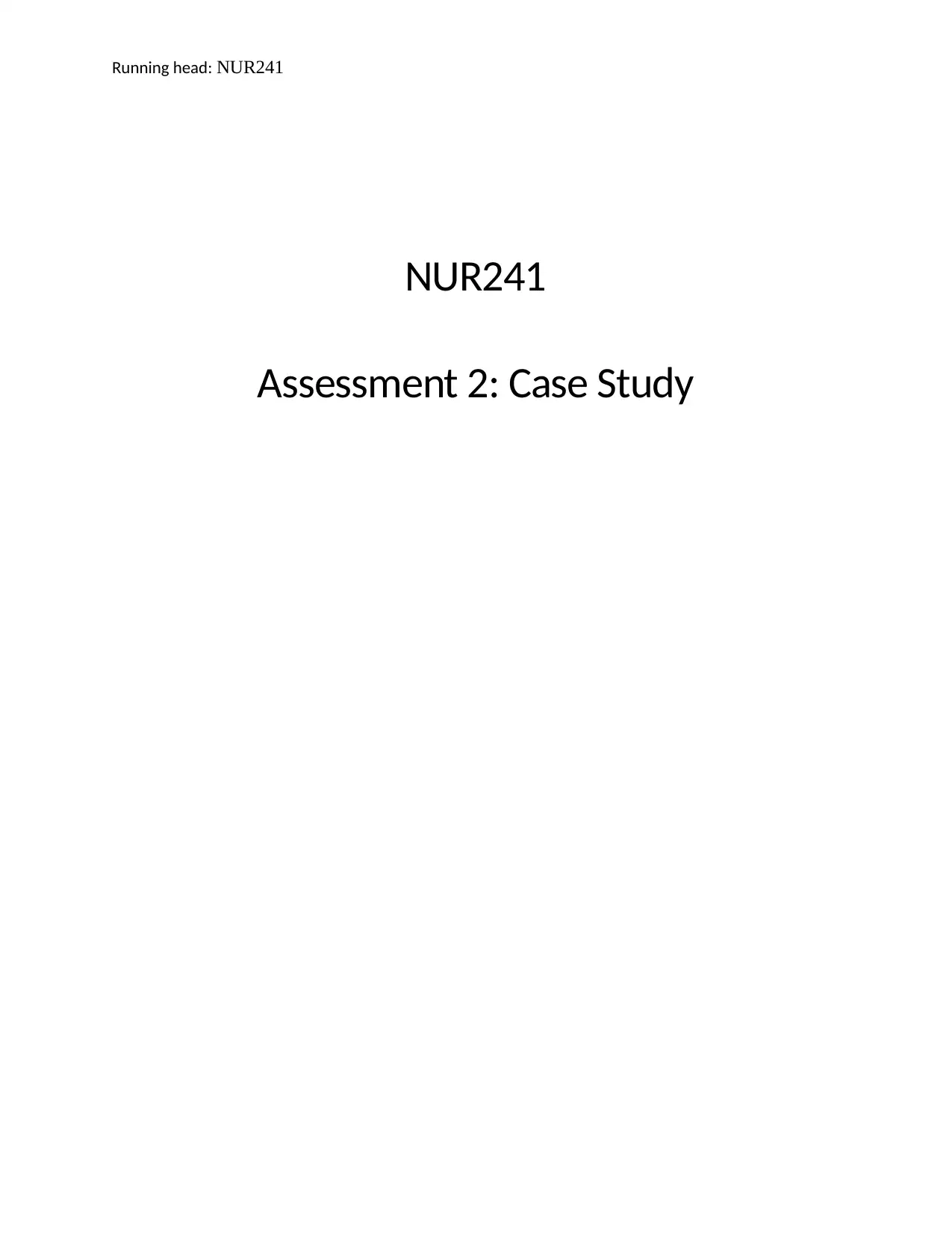
Running head: NUR241
NUR241
Assessment 2: Case Study
NUR241
Assessment 2: Case Study
Paraphrase This Document
Need a fresh take? Get an instant paraphrase of this document with our AI Paraphraser
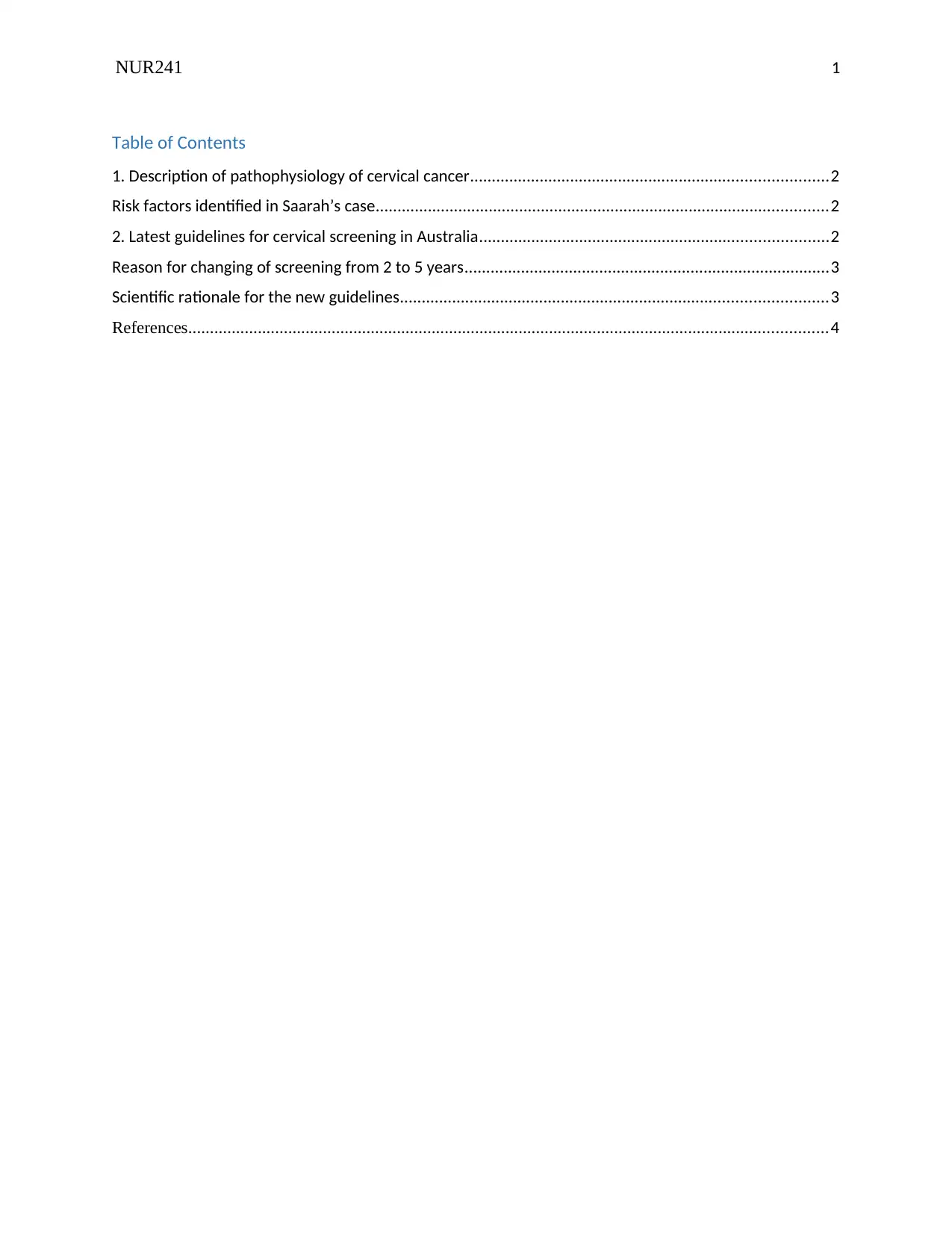
NUR241 1
Table of Contents
1. Description of pathophysiology of cervical cancer..................................................................................2
Risk factors identified in Saarah’s case........................................................................................................2
2. Latest guidelines for cervical screening in Australia................................................................................2
Reason for changing of screening from 2 to 5 years....................................................................................3
Scientific rationale for the new guidelines..................................................................................................3
References...................................................................................................................................................4
Table of Contents
1. Description of pathophysiology of cervical cancer..................................................................................2
Risk factors identified in Saarah’s case........................................................................................................2
2. Latest guidelines for cervical screening in Australia................................................................................2
Reason for changing of screening from 2 to 5 years....................................................................................3
Scientific rationale for the new guidelines..................................................................................................3
References...................................................................................................................................................4
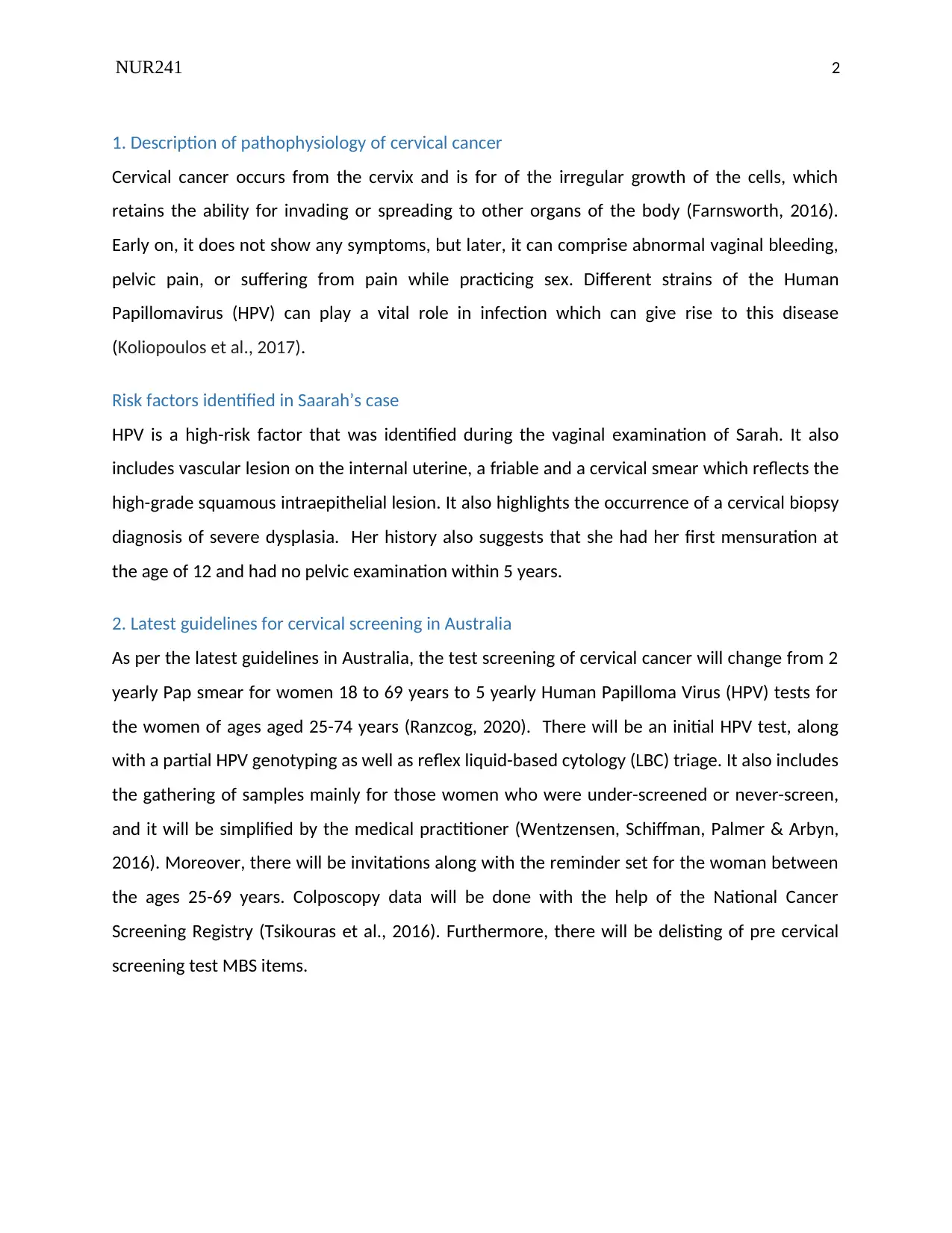
NUR241 2
1. Description of pathophysiology of cervical cancer
Cervical cancer occurs from the cervix and is for of the irregular growth of the cells, which
retains the ability for invading or spreading to other organs of the body (Farnsworth, 2016).
Early on, it does not show any symptoms, but later, it can comprise abnormal vaginal bleeding,
pelvic pain, or suffering from pain while practicing sex. Different strains of the Human
Papillomavirus (HPV) can play a vital role in infection which can give rise to this disease
(Koliopoulos et al., 2017).
Risk factors identified in Saarah’s case
HPV is a high-risk factor that was identified during the vaginal examination of Sarah. It also
includes vascular lesion on the internal uterine, a friable and a cervical smear which reflects the
high-grade squamous intraepithelial lesion. It also highlights the occurrence of a cervical biopsy
diagnosis of severe dysplasia. Her history also suggests that she had her first mensuration at
the age of 12 and had no pelvic examination within 5 years.
2. Latest guidelines for cervical screening in Australia
As per the latest guidelines in Australia, the test screening of cervical cancer will change from 2
yearly Pap smear for women 18 to 69 years to 5 yearly Human Papilloma Virus (HPV) tests for
the women of ages aged 25-74 years (Ranzcog, 2020). There will be an initial HPV test, along
with a partial HPV genotyping as well as reflex liquid-based cytology (LBC) triage. It also includes
the gathering of samples mainly for those women who were under-screened or never-screen,
and it will be simplified by the medical practitioner (Wentzensen, Schiffman, Palmer & Arbyn,
2016). Moreover, there will be invitations along with the reminder set for the woman between
the ages 25-69 years. Colposcopy data will be done with the help of the National Cancer
Screening Registry (Tsikouras et al., 2016). Furthermore, there will be delisting of pre cervical
screening test MBS items.
1. Description of pathophysiology of cervical cancer
Cervical cancer occurs from the cervix and is for of the irregular growth of the cells, which
retains the ability for invading or spreading to other organs of the body (Farnsworth, 2016).
Early on, it does not show any symptoms, but later, it can comprise abnormal vaginal bleeding,
pelvic pain, or suffering from pain while practicing sex. Different strains of the Human
Papillomavirus (HPV) can play a vital role in infection which can give rise to this disease
(Koliopoulos et al., 2017).
Risk factors identified in Saarah’s case
HPV is a high-risk factor that was identified during the vaginal examination of Sarah. It also
includes vascular lesion on the internal uterine, a friable and a cervical smear which reflects the
high-grade squamous intraepithelial lesion. It also highlights the occurrence of a cervical biopsy
diagnosis of severe dysplasia. Her history also suggests that she had her first mensuration at
the age of 12 and had no pelvic examination within 5 years.
2. Latest guidelines for cervical screening in Australia
As per the latest guidelines in Australia, the test screening of cervical cancer will change from 2
yearly Pap smear for women 18 to 69 years to 5 yearly Human Papilloma Virus (HPV) tests for
the women of ages aged 25-74 years (Ranzcog, 2020). There will be an initial HPV test, along
with a partial HPV genotyping as well as reflex liquid-based cytology (LBC) triage. It also includes
the gathering of samples mainly for those women who were under-screened or never-screen,
and it will be simplified by the medical practitioner (Wentzensen, Schiffman, Palmer & Arbyn,
2016). Moreover, there will be invitations along with the reminder set for the woman between
the ages 25-69 years. Colposcopy data will be done with the help of the National Cancer
Screening Registry (Tsikouras et al., 2016). Furthermore, there will be delisting of pre cervical
screening test MBS items.
⊘ This is a preview!⊘
Do you want full access?
Subscribe today to unlock all pages.

Trusted by 1+ million students worldwide
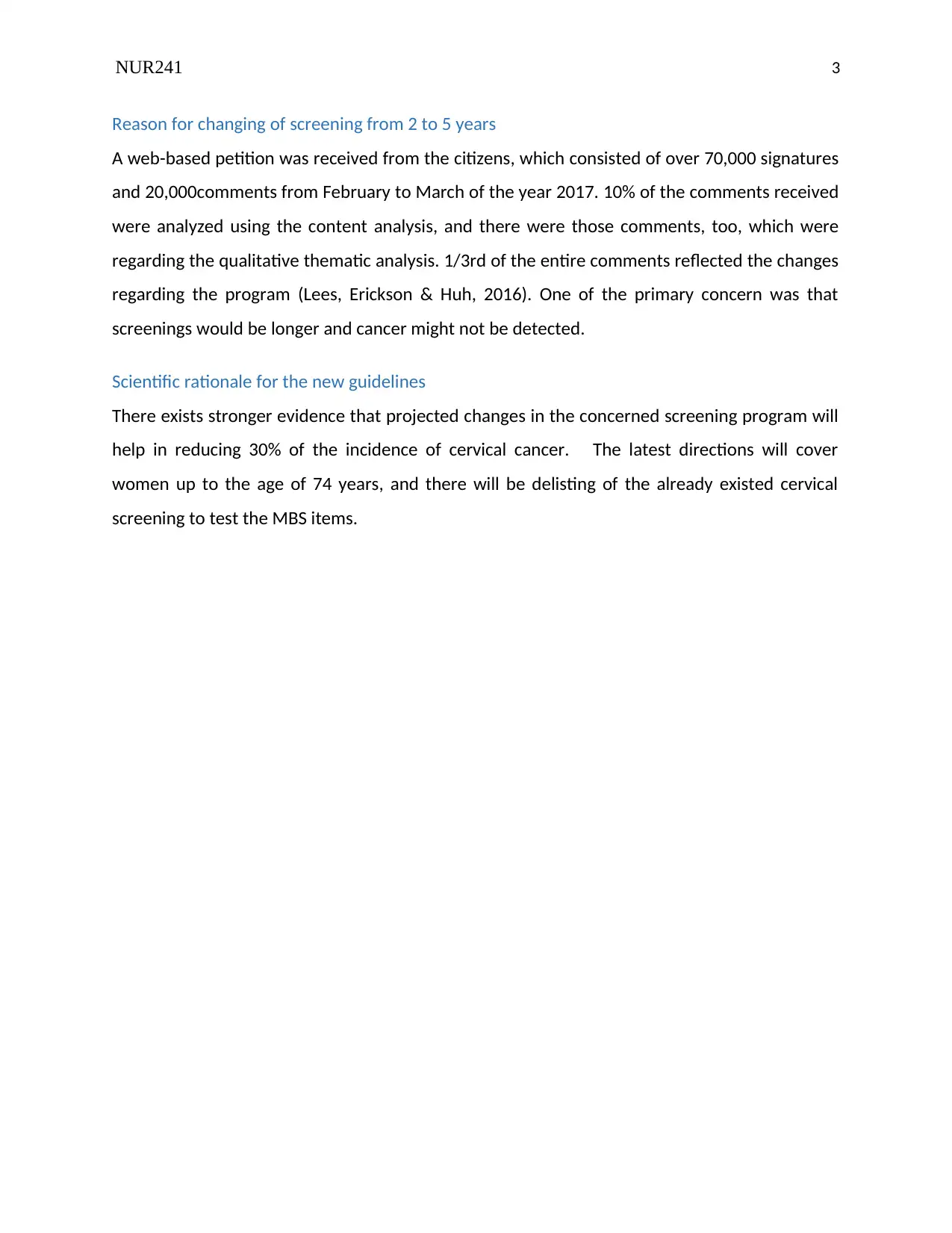
NUR241 3
Reason for changing of screening from 2 to 5 years
A web-based petition was received from the citizens, which consisted of over 70,000 signatures
and 20,000comments from February to March of the year 2017. 10% of the comments received
were analyzed using the content analysis, and there were those comments, too, which were
regarding the qualitative thematic analysis. 1/3rd of the entire comments reflected the changes
regarding the program (Lees, Erickson & Huh, 2016). One of the primary concern was that
screenings would be longer and cancer might not be detected.
Scientific rationale for the new guidelines
There exists stronger evidence that projected changes in the concerned screening program will
help in reducing 30% of the incidence of cervical cancer. The latest directions will cover
women up to the age of 74 years, and there will be delisting of the already existed cervical
screening to test the MBS items.
Reason for changing of screening from 2 to 5 years
A web-based petition was received from the citizens, which consisted of over 70,000 signatures
and 20,000comments from February to March of the year 2017. 10% of the comments received
were analyzed using the content analysis, and there were those comments, too, which were
regarding the qualitative thematic analysis. 1/3rd of the entire comments reflected the changes
regarding the program (Lees, Erickson & Huh, 2016). One of the primary concern was that
screenings would be longer and cancer might not be detected.
Scientific rationale for the new guidelines
There exists stronger evidence that projected changes in the concerned screening program will
help in reducing 30% of the incidence of cervical cancer. The latest directions will cover
women up to the age of 74 years, and there will be delisting of the already existed cervical
screening to test the MBS items.
Paraphrase This Document
Need a fresh take? Get an instant paraphrase of this document with our AI Paraphraser
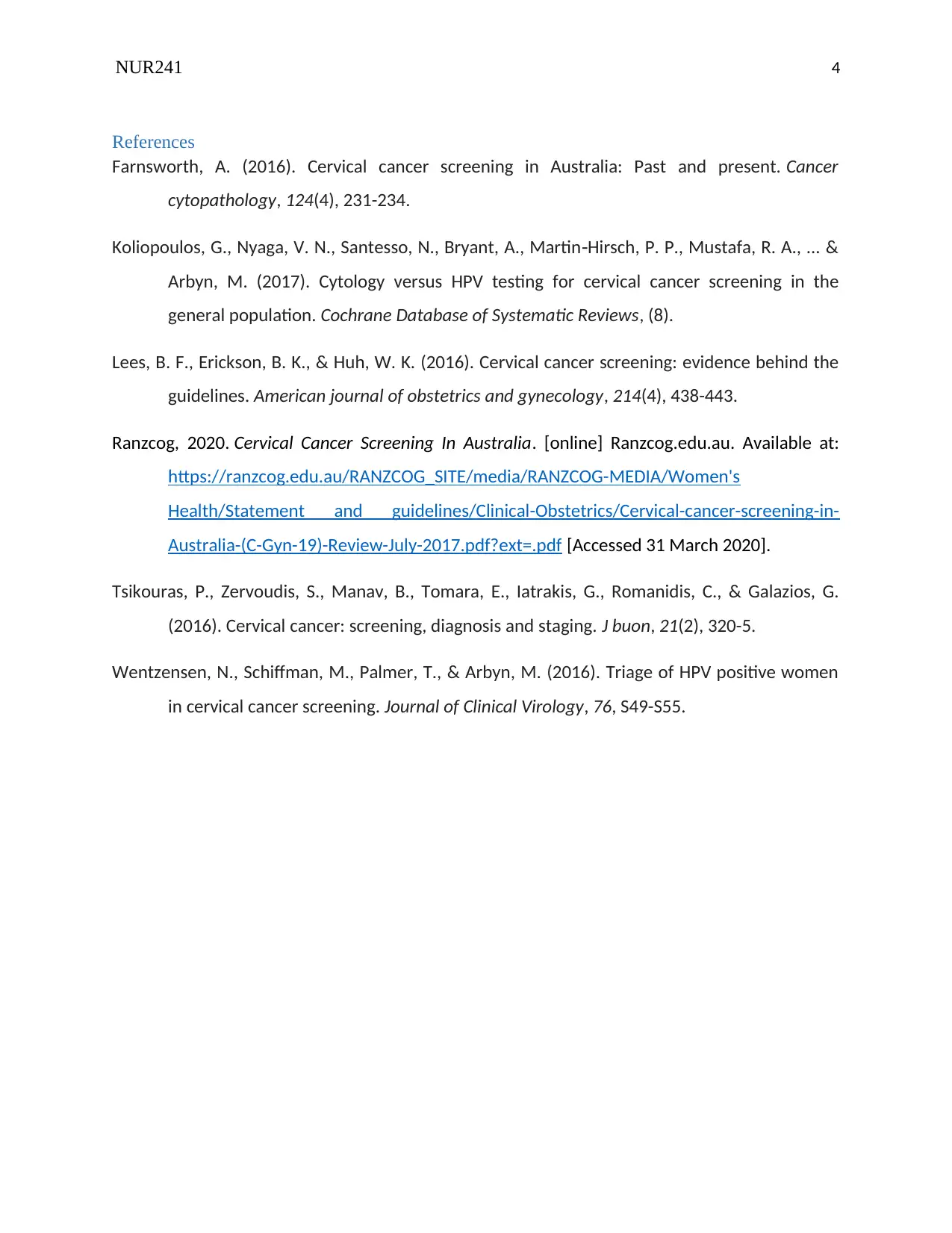
NUR241 4
References
Farnsworth, A. (2016). Cervical cancer screening in Australia: Past and present. Cancer
cytopathology, 124(4), 231-234.
Koliopoulos, G., Nyaga, V. N., Santesso, N., Bryant, A., Martin Hirsch, P. P., Mustafa, R. A., ... &‐
Arbyn, M. (2017). Cytology versus HPV testing for cervical cancer screening in the
general population. Cochrane Database of Systematic Reviews, (8).
Lees, B. F., Erickson, B. K., & Huh, W. K. (2016). Cervical cancer screening: evidence behind the
guidelines. American journal of obstetrics and gynecology, 214(4), 438-443.
Ranzcog, 2020. Cervical Cancer Screening In Australia. [online] Ranzcog.edu.au. Available at:
https://ranzcog.edu.au/RANZCOG_SITE/media/RANZCOG-MEDIA/Women's
Health/Statement and guidelines/Clinical-Obstetrics/Cervical-cancer-screening-in-
Australia-(C-Gyn-19)-Review-July-2017.pdf?ext=.pdf [Accessed 31 March 2020].
Tsikouras, P., Zervoudis, S., Manav, B., Tomara, E., Iatrakis, G., Romanidis, C., & Galazios, G.
(2016). Cervical cancer: screening, diagnosis and staging. J buon, 21(2), 320-5.
Wentzensen, N., Schiffman, M., Palmer, T., & Arbyn, M. (2016). Triage of HPV positive women
in cervical cancer screening. Journal of Clinical Virology, 76, S49-S55.
References
Farnsworth, A. (2016). Cervical cancer screening in Australia: Past and present. Cancer
cytopathology, 124(4), 231-234.
Koliopoulos, G., Nyaga, V. N., Santesso, N., Bryant, A., Martin Hirsch, P. P., Mustafa, R. A., ... &‐
Arbyn, M. (2017). Cytology versus HPV testing for cervical cancer screening in the
general population. Cochrane Database of Systematic Reviews, (8).
Lees, B. F., Erickson, B. K., & Huh, W. K. (2016). Cervical cancer screening: evidence behind the
guidelines. American journal of obstetrics and gynecology, 214(4), 438-443.
Ranzcog, 2020. Cervical Cancer Screening In Australia. [online] Ranzcog.edu.au. Available at:
https://ranzcog.edu.au/RANZCOG_SITE/media/RANZCOG-MEDIA/Women's
Health/Statement and guidelines/Clinical-Obstetrics/Cervical-cancer-screening-in-
Australia-(C-Gyn-19)-Review-July-2017.pdf?ext=.pdf [Accessed 31 March 2020].
Tsikouras, P., Zervoudis, S., Manav, B., Tomara, E., Iatrakis, G., Romanidis, C., & Galazios, G.
(2016). Cervical cancer: screening, diagnosis and staging. J buon, 21(2), 320-5.
Wentzensen, N., Schiffman, M., Palmer, T., & Arbyn, M. (2016). Triage of HPV positive women
in cervical cancer screening. Journal of Clinical Virology, 76, S49-S55.
1 out of 5
Related Documents
Your All-in-One AI-Powered Toolkit for Academic Success.
+13062052269
info@desklib.com
Available 24*7 on WhatsApp / Email
![[object Object]](/_next/static/media/star-bottom.7253800d.svg)
Unlock your academic potential
Copyright © 2020–2025 A2Z Services. All Rights Reserved. Developed and managed by ZUCOL.





